Math Writing Questions Test 2
Which choice best maintains the sentence pattern already established in the paragraph?
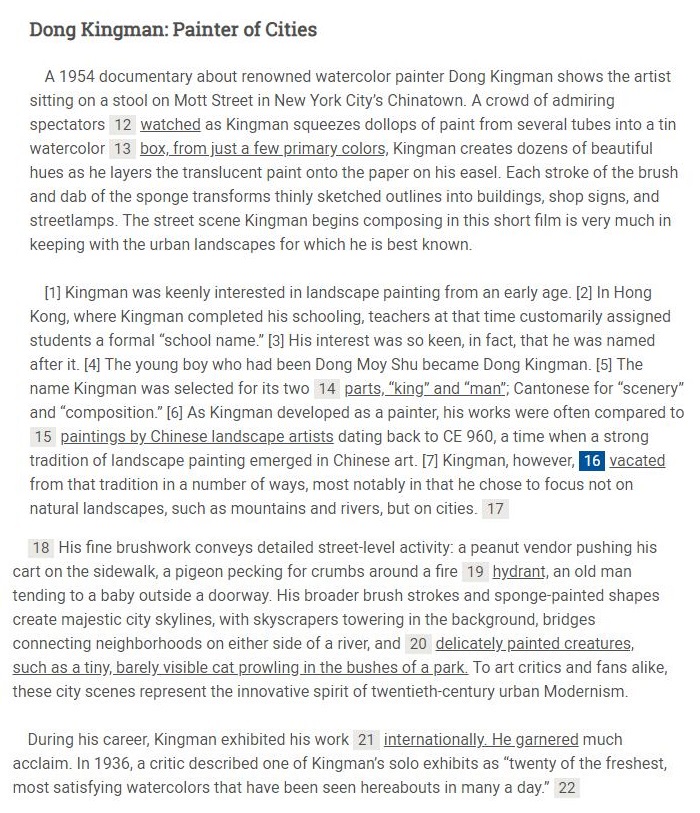
Choice C is the best answer because “departed” is the most contextually appropriate way to indicate that Kingman had deviated from the tradition of Chinese landscape painting in a number of ways. Choice A is not the best answer because while “vacated” does offer some sense of “leaving,” it would be awkward and unconventional to say that that a person was vacating from a tradition in a number of ways. Choice B is not the best answer because while “evacuated” does offer some sense of “leaving,” it would be awkward and unconventional to say that a person was evacuating from a tradition in a number of ways. Choice D is not the best answer because while “retired” does offer some sense of “leaving,” it would be awkward and unconventional to say that a person was retiring from a tradition in a number of ways.
Which choice best maintains the sentence pattern already established in the paragraph?
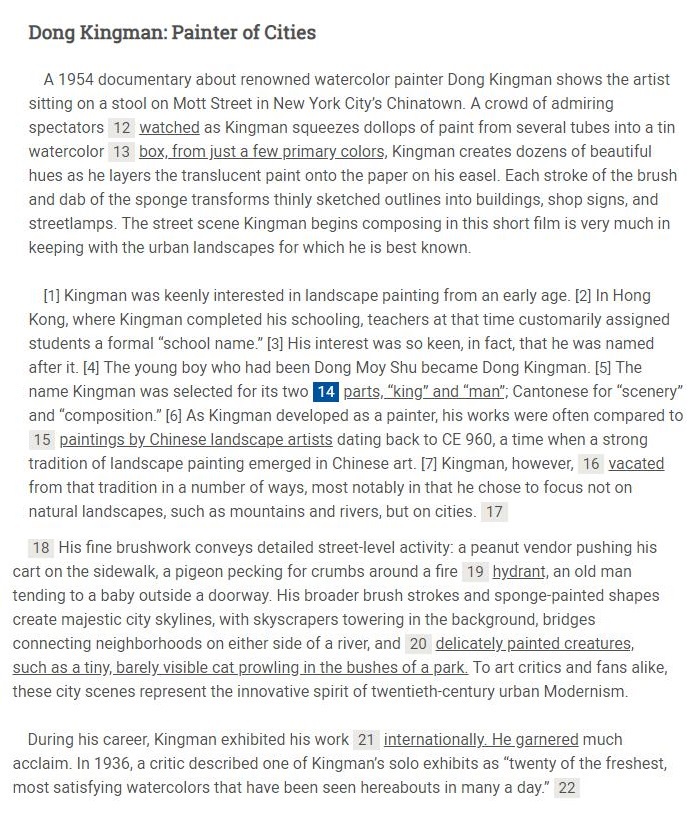
Choice B is the best answer because the colon after “parts” effectively signals that what follows in the sentence further defines what the “two parts” of Kingman’s name are and because the comma after “man” properly indicates that “‘king’ and ‘man’” and “Cantonese for ‘scenery’ and ‘composition’” are nonrestrictive appositives. Choice A is not the best answer because the semicolon after “man” incorrectly joins an independent clause and a phrase. Moreover, the comma after “parts” is arguably a weak form of punctuation to be signaling the strong break in the sentence indicated here. Choice C is not the best answer because the semicolon after “man” incorrectly joins an independent clause and a phrase and because the absence of a comma after “parts” fails to indicate that “two parts” and “‘king’ and ‘man’” are nonrestrictive appositives. Choice D is not the best answer because the semicolon after “parts” incorrectly joins an independent clause and phrases and because the absence of a comma after “man” fails to indicate that “‘king’ and ‘man’” and “Cantonese for ‘scenery’ and ‘composition’” are nonrestrictive appositives.
Which choice best maintains the sentence pattern already established in the paragraph?
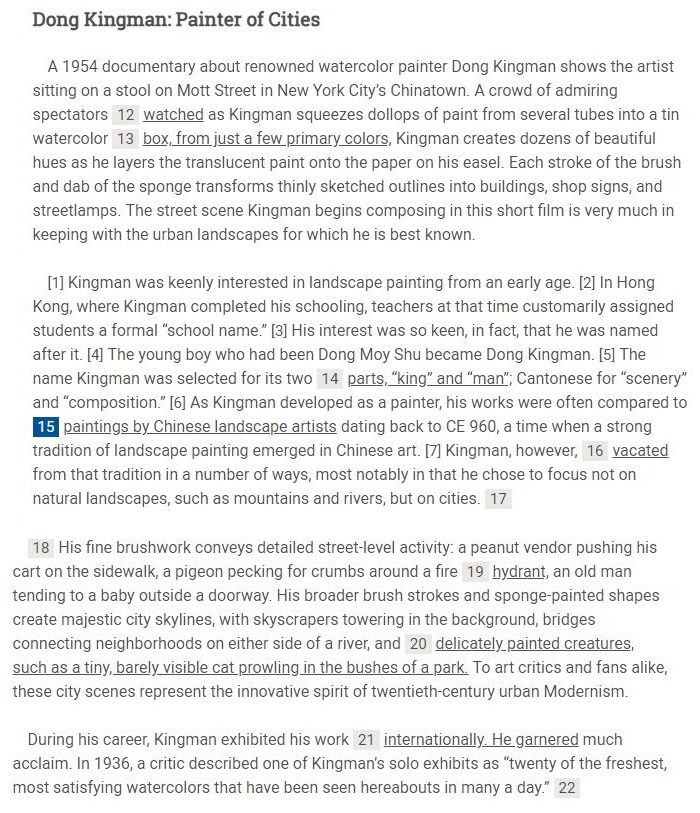
Choice A is the best answer because it creates a comparison between like terms: “works” by Kingman and “paintings by Chinese landscape artists.” Choice B is not the best answer because it creates a comparison between unlike terms: “works” by Kingman and “Chinese landscape artists.” Choice C is not the best answer because it creates a comparison between unlike terms: “works” by Kingman and “painters of Chinese landscapes.” Choice D is not the best answer because it creates a comparison between unlike terms: “works” by Kingman and “artists.”
Which choice best maintains the sentence pattern already established in the paragraph?
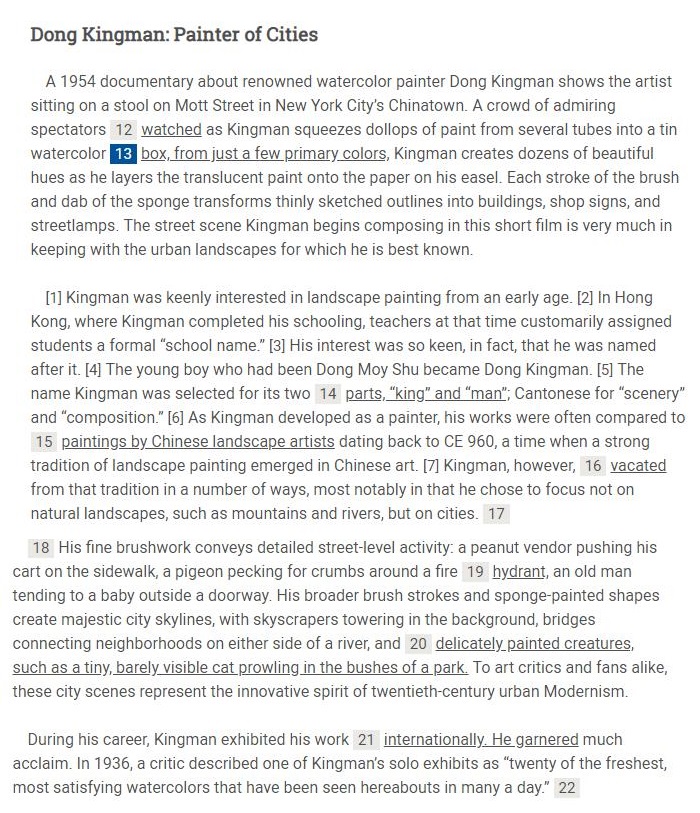
Choice B is the best answer because it provides punctuation that creates two grammatically complete and standard sentences. Choice A is not the best answer because it results in a comma splice as well as some confusion about what the prepositional phrase “from just a few primary colors” modifies. Choice C is not the best answer because it results in a run-on sentence as well as some confusion about what the prepositional phrase “from just a few primary colors” modifies. Choice D is not the best answer because it results in a comma splice.
Which choice best maintains the sentence pattern already established in the paragraph?
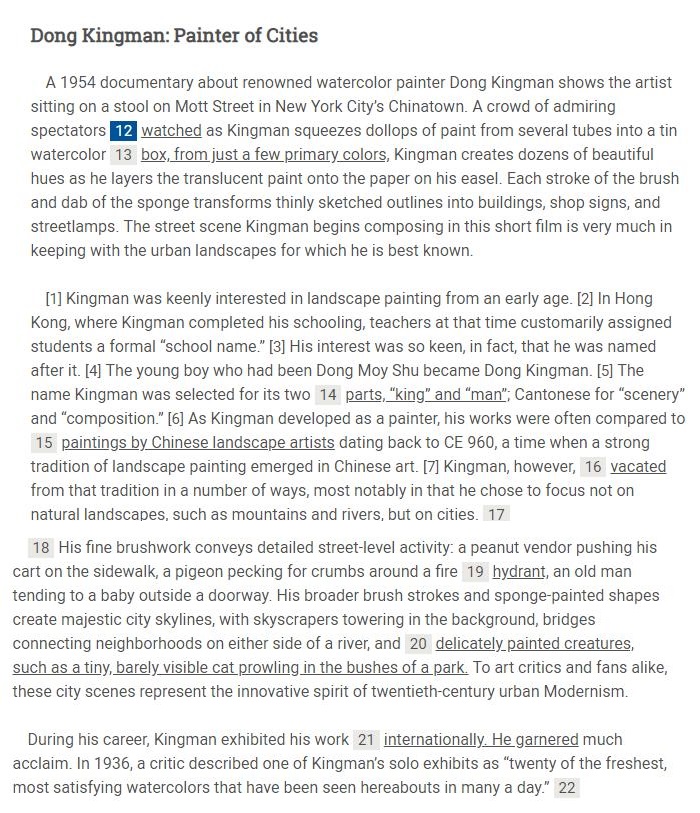
Choice D is the best answer because the simple present tense verb “watches” is consistent with the tense of the verbs in the rest of the sentence and paragraph. Choice A is not the best answer because “watched” creates an inappropriate shift to the past tense. Choice B is not the best answer because “had watched” creates an inappropriate shift to the past perfect tense. Choice C is not the best answer because “would watch” creates an inappropriate shift that suggests a habitual aspect (other verbs in the sentence and paragraph, however, indicate that a specific instance is being narrated).
To make this paragraph most logical, sentence 3 should be placed
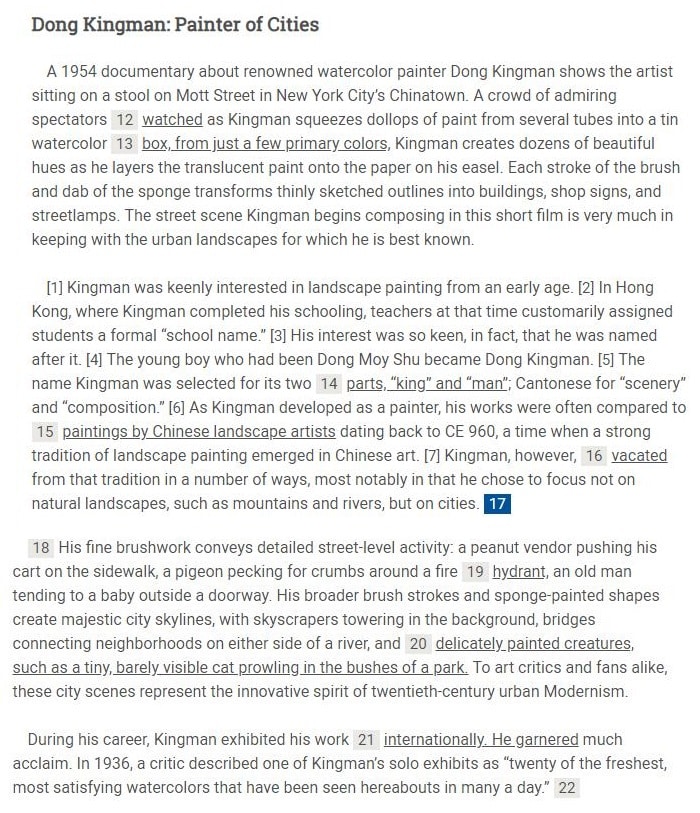
Choice C is the best answer because placing sentence 3 after sentence 1 makes the paragraph most cohesive. Sentence 3 refers to Kingman’s “interest” being “so keen,” a continuation of the idea in sentence 1, which says that “Kingman was keenly interested in landscape painting from an early age.” Choice A is not the best answer because leaving sentence 3 where it is now creates a sequence of sentences that lacks sufficient cohesion. Keeping sentence 3 in its current location disrupts the link between sentence 2 (which describes the concept of “school names” in Hong Kong) and sentence 4 (which reveals that Dong Kingman was the school name of Dong Moy Shu). Choice B is not the best answer because placing sentence 3 before sentence 1 creates a sequence of sentences that lacks sufficient cohesion. Putting sentence 3 at the beginning of the paragraph would offer a poor introduction to the paragraph, in large part because sentence 3 builds directly on a point made in sentence 1. Choice D is not the best answer because placing sentence 3 after sentence 4 creates a sequence of sentences that lacks sufficient cohesion. Putting sentence 3 after sentence 4 would disrupt the link between sentence 4 (which mentions that Dong Moy Shu was given the school name Dong Kingman) and sentence 5 (which explains what the two parts comprising the name Kingman mean in Cantonese).
The writer wants to conclude the passage with a sentence that emphasizes an enduring legacy of Kingman’s work. Which choice would best accomplish this goal?
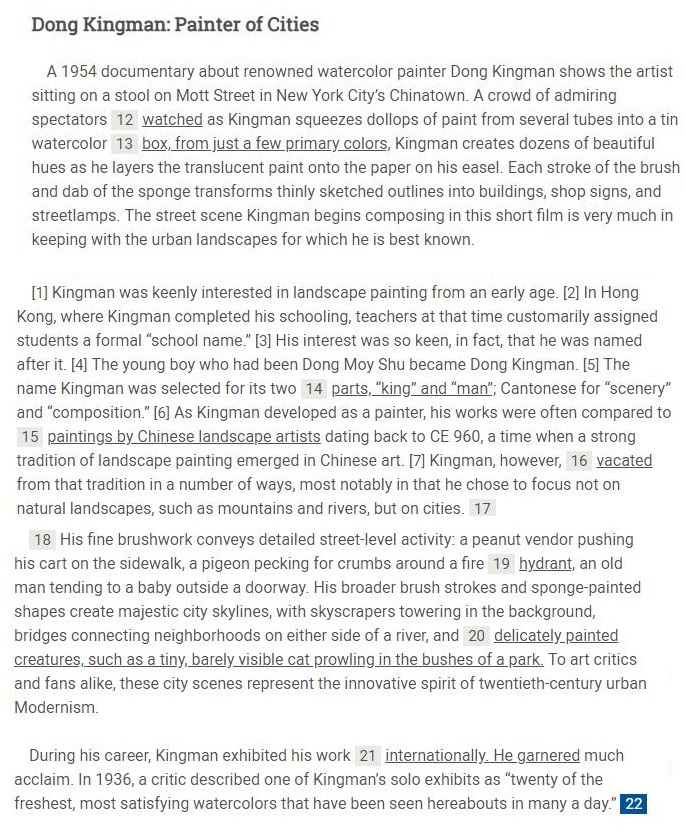
Choice B is the best answer because it concludes the passage with a sentence that emphasizes the enduring legacy of Kingman’s work by indicating that museums continue to make Kingman’s iconic paintings accessible to the public. Choice A is not the best answer because it concludes the passage with a sentence that acknowledges that other painters’ work is more famous than Kingman’s (which downplays, rather than emphasizes, the enduring legacy of Kingman’s work) and offers only a general assertion that Kingman’s work is “well regarded by many people.” Choice C is not the best answer because instead of referring to the enduring legacy of Kingman’s work, it concludes the passage with a sentence that recalls a detail the passage provides about Kingman’s early life. Choice D is not the best answer because it concludes the passage with a sentence that is too vague and general to emphasize effectively an enduring legacy of Kingman’s work. It is not clear what the idea of refreshing a long-lasting tradition is intended to mean or how (or even whether) this represents an enduring legacy. Moreover, referring to Kingman’s work as “but one example” downplays the significance of any potential legacy that might be suggested.
Which choice best maintains the sentence pattern already established in the paragraph?
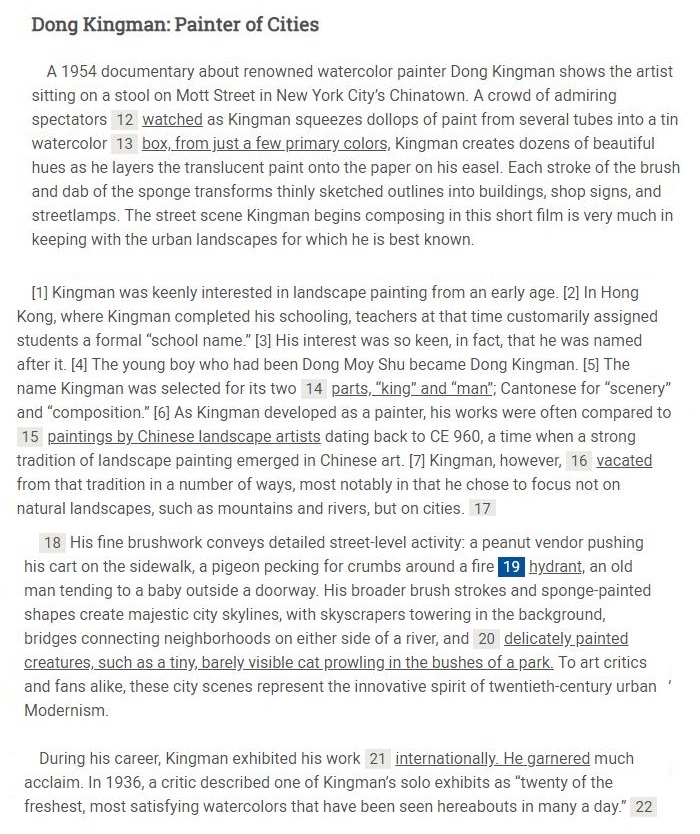
Choice A is the best answer because a comma after the word “hydrant” separates the phrase “a pigeon pecking for crumbs around a fire hydrant” from the phrase “an old man tending to a baby outside a doorway.” A comma is also consistent with the punctuation choice made to separate the first two phrases in the asyndetic series following the colon in the sentence. Choice B is not the best answer because a dash is not a conventional choice for punctuating items in a series. Choice C is not the best answer because although a colon can be used to introduce a series, it is not an conventional choice for separating items within a series. Choice D is not the best answer because it fuses together two items in the series. Separating the phrases “a pigeon pecking for crumbs around a fire hydrant” and “an old man tending to a baby outside a doorway” requires punctuation and/or a coordinating conjunction.
The writer wants to complete the sentence with a third example of a detail Kingman uses to create his majestic city skylines. Which choice best accomplishes this goal?
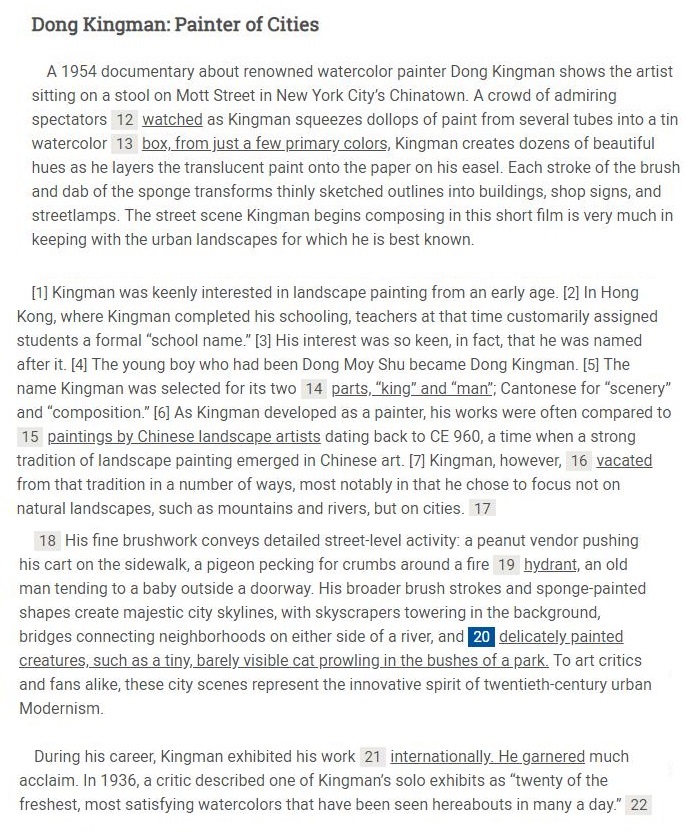
Choice D is the best answer because the phrase “enormous ships docking at busy urban ports” effectively continues the sentence’s series of details (“skyscrapers towering in the background” and “bridges connecting neighborhoods”) conveying the majesty of city skylines as depicted by Kingman. Choice A is not the best answer because the phrase “delicately painted creatures, such as a tiny, barely visible cat prowling in the bushes of a park” does not convey a sense of the majesty of city skylines as depicted by Kingman and thus does not effectively continue the sentence’s series of details (“skyscrapers towering in the background” and “bridges connecting neighborhoods”). Choice B is not the best answer because the phrase “exquisitely lettered street and storefront signs” does not convey a sense of the majesty of city skylines as depicted by Kingman and thus does not effectively continue the sentence’s series of details (“skyscrapers towering in the background” and “bridges connecting neighborhoods”). Choice C is not the best answer because the phrase “other details that help define Kingman’s urban landscapes” is too vague and general to constitute a third example that conveys a sense of the majesty of city skylines as depicted by Kingman and thus does not effectively continue the sentence’s series of details (“skyscrapers towering in the background” and “bridges connecting neighborhoods”).
Which choice most effectively combines the sentences at the underlined portion?
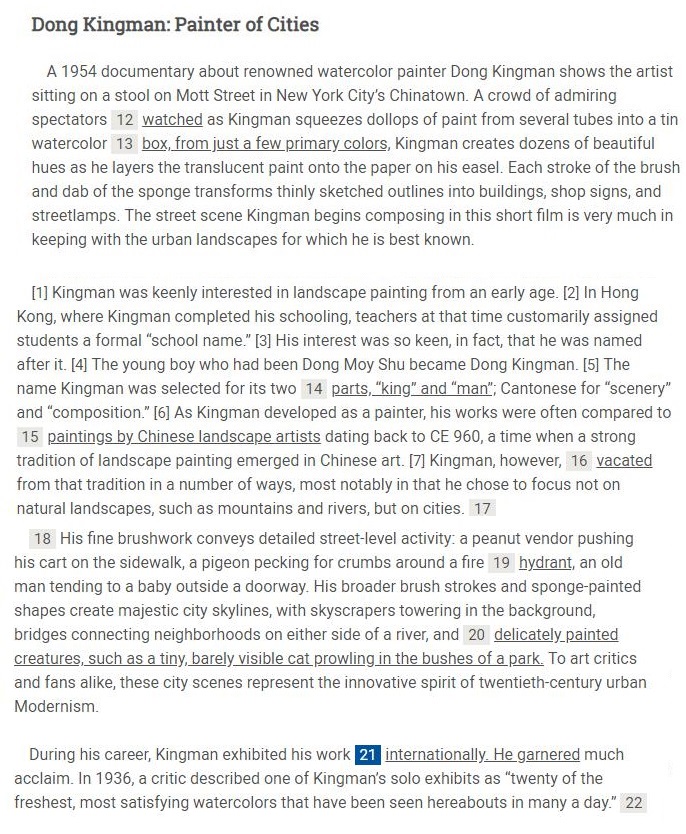
Choice D is the best answer because it combines the sentences logically and efficiently, with the original second sentence becoming a participial phrase describing Kingman. Choice A is not the best answer because it creates a wordy and awkward construction and because it fails to link the acclaim Kingman received with the exhibition of his work. Choice B is not the best answer because it creates a repetitive and awkward construction. Choice C is not the best answer because “but” suggests contrast or exception, neither of which makes sense in the context of the sentence.
Which choice most effectively establishes the main topic of the paragraph?
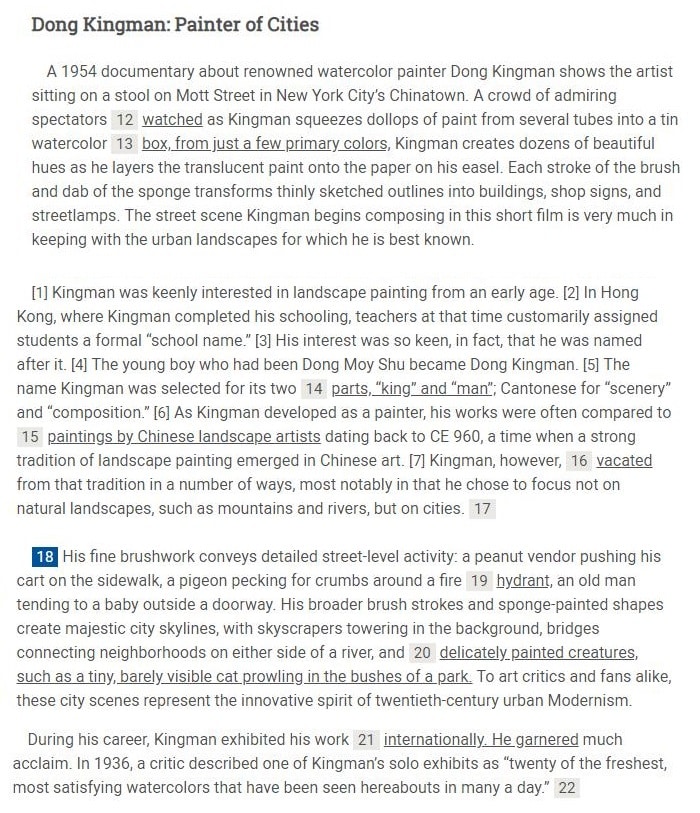
Choice C is the best answer because it clearly establishes the main topic of the paragraph: Kingman’s urban landscapes. Choice A is not the best answer because it would begin the paragraph with a loosely related detail about Kingman’s painting style and would not clearly establish the main topic of the paragraph. Choice B is not the best answer because it would suggest that the main topic of the paragraph is the natural landscapes Kingman occasionally painted, which is incorrect given the focus of the rest of the sentences in the paragraph. Choice D is not the best answer because it would begin the paragraph with a loosely related detail about Kingman’s life and would not clearly establish the main topic of the paragraph.